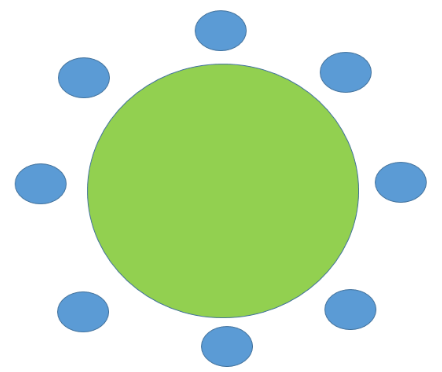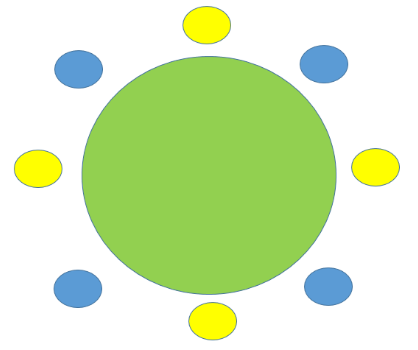
In how many ways 4 married couples are to be seated round a table if no husband and wife as well as no two men are to be in adjacent seats.
A) 384
B) 14
C) 24
D) 36
Answer
573.3k+ views
Hint: We will first make a round table for our reference with 8 seats on it. Now, we will first find the number of ways men can be seated alternatively and then arrange women according to that.
Complete step-by-step answer:
Let us refer to the figure given below:

Here, the green circle represents the table and the small blue circles around it represent the seats.
Now, we need no men to sit together in adjacent seats. So, we need them to sit alternatively.
Without any loss of generality, let them be seated as follows:

Here, the yellow circles are representing the men seated around the table. Now, this can be done in 4! Ways because, first yellow portion can be taken by 4 men, then second by 3 men, third by 2 men and fourth by last man.
Hence, men can sit in $4! = 4 \times 3 \times 2 = 24$ ways.
Now, corresponding to these ways, we need to arrange women such that they are not adjacent to their husband.
Since, one blue chair is adjacent to 2 men. Hence, only two women can sit there, which are the wives of the other 2 men. The same thing will happen for each of the 4 seats.
Hence, women can be arranged in $2 \times 2 \times 2 \times 2 = 16$ ways.
Hence, the total number of arrangements are $24 \times 16 = 384$ ways.
Hence, the correct option is (A).
Note: The students might make the mistake of adding both the arrangements of women and men. But they must remember that we are not making different arrangements but corresponding to men, how women can be arranged. So, we need to multiply these in order to get our answer.
The students must note that if we directly approached the problem without the use of Permutation and Combination, it would take too much of time and would be filled with hassle and chaos because we would have to write 384 possible combinations which would have taken forever. Therefore, Permutation and Combination has made our work extremely easy. We do not have to write each of the arrangements and just get the number of arrangements directly by some calculations.
Complete step-by-step answer:
Let us refer to the figure given below:

Here, the green circle represents the table and the small blue circles around it represent the seats.
Now, we need no men to sit together in adjacent seats. So, we need them to sit alternatively.
Without any loss of generality, let them be seated as follows:

Here, the yellow circles are representing the men seated around the table. Now, this can be done in 4! Ways because, first yellow portion can be taken by 4 men, then second by 3 men, third by 2 men and fourth by last man.
Hence, men can sit in $4! = 4 \times 3 \times 2 = 24$ ways.
Now, corresponding to these ways, we need to arrange women such that they are not adjacent to their husband.
Since, one blue chair is adjacent to 2 men. Hence, only two women can sit there, which are the wives of the other 2 men. The same thing will happen for each of the 4 seats.
Hence, women can be arranged in $2 \times 2 \times 2 \times 2 = 16$ ways.
Hence, the total number of arrangements are $24 \times 16 = 384$ ways.
Hence, the correct option is (A).
Note: The students might make the mistake of adding both the arrangements of women and men. But they must remember that we are not making different arrangements but corresponding to men, how women can be arranged. So, we need to multiply these in order to get our answer.
The students must note that if we directly approached the problem without the use of Permutation and Combination, it would take too much of time and would be filled with hassle and chaos because we would have to write 384 possible combinations which would have taken forever. Therefore, Permutation and Combination has made our work extremely easy. We do not have to write each of the arrangements and just get the number of arrangements directly by some calculations.
Recently Updated Pages
Why are manures considered better than fertilizers class 11 biology CBSE

Find the coordinates of the midpoint of the line segment class 11 maths CBSE

Distinguish between static friction limiting friction class 11 physics CBSE

The Chairman of the constituent Assembly was A Jawaharlal class 11 social science CBSE

The first National Commission on Labour NCL submitted class 11 social science CBSE

Number of all subshell of n + l 7 is A 4 B 5 C 6 D class 11 chemistry CBSE

Trending doubts
Differentiate between an exothermic and an endothermic class 11 chemistry CBSE

10 examples of friction in our daily life

One Metric ton is equal to kg A 10000 B 1000 C 100 class 11 physics CBSE

Difference Between Prokaryotic Cells and Eukaryotic Cells

1 Quintal is equal to a 110 kg b 10 kg c 100kg d 1000 class 11 physics CBSE

State the laws of reflection of light




